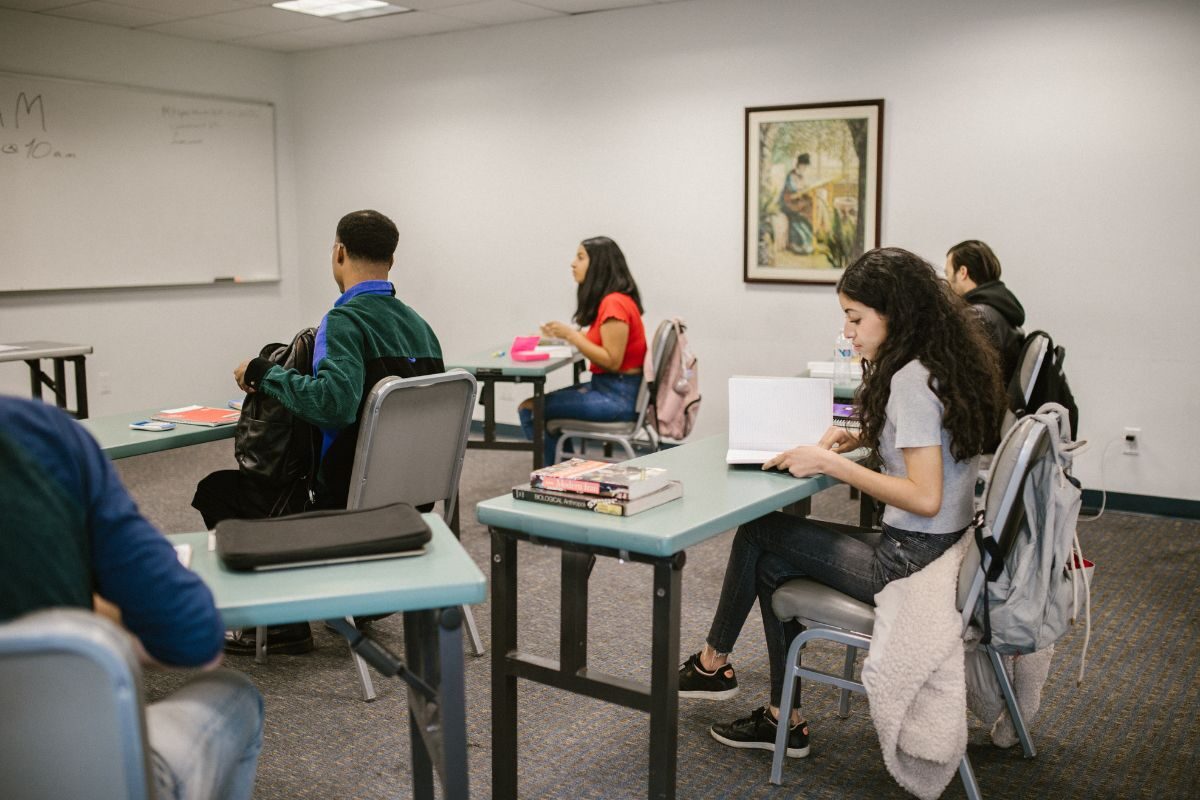Record number of teachers in England’s schools

- Nearly 48,000 full time equivalent teachers joined English schools in the 2022/2023 academic year, with 2,800 more teachers now in classrooms than last year
- This follows a range of recruitment and retention initiatives, including our bursaries, scholarships and levelling up premium
- Driving up standards and providing a world class education continues to be a priority for the Government
Schools in England now have more teachers than ever before, as new data reveals there are 468,371 teachers in the workforce, as part of the Government’s ongoing work to attract the brightest and the best to the profession.
The School Workforce Census published today (8 June) shows that nearly 48,000 teachers entered classrooms in the 2022-2023 academic year. This means there are over 27,000 more teachers in classrooms since 2010 and 2,800 more than last year.
The Government has also put in place a range of measures to boost recruitment and retention. In October 2022, the department announced a further increase to the teacher training financial incentives package – with an additional £52m more invested on the previous year. This includes bursaries worth £27,000 tax-free and scholarships worth £29,000 tax-free, which encourage talented trainees to teach key subjects such as mathematics, physics, chemistry and computing.
On top of this, the Levelling Up Premium worth up to £3,000 tax-free annually is available for maths, physics, chemistry and computing teachers who choose to work in disadvantaged schools in the first five years of their careers. This is helping to support the recruitment and retention of specialist in areas that need them most.
More great teachers in classrooms helps build a world class education system for our children and young people to learn and develop in, and builds on the Government’s work to drive up school standards including the Prime Minister’s ambitions, set out in January, to boost Maths to 18. England’s recent performance in the Progress in International Reading Literacy Study (PIRLS), where it placed 4th in the world for reading among primary school children, demonstrate the progress made in attainment and teachers are central to this success.
Education Secretary, Gillian Keegan, said:
“A great education does not happen by chance, and brilliant teachers shape children’s lives every day.
“In today’s competitive job market, it is fantastic to see so many people choosing a rewarding teaching career, with a record number of teachers now working in our schools.
“We know there is more to do, which is why we have generous bursaries to attract new trainees to teach priority subjects and focusing on supporting new teachers from the very start of their journey with free, high-quality, ongoing professional development.”
Today’s data shows the majority of subjects continued to be taught by specialist teachers, with 87.4% of EBacc teaching hours in secondary schools (English, maths, all sciences, history geography and modern foreign languages) taught by a teacher with a relevant post-A level qualification. In Maths 87.2% of hours were taught by a specialist, helping drive the Government’s priority of boosting Maths attainment.
In addition to the number of teachers, the number of support staff has continued to grow for a third year in a row and, at 281,094, there are now a record number of teaching assistants, having risen by 5,300 since last year. This ensures pupils get the support they need to help them learn.
The Department is continuing to deliver major reforms to teacher training, including the Early Career Framework and delivery of National Professional Qualifications. The Government is delivering teacher training and development opportunities for every teacher that wants one, giving all teachers and school leaders access to world-class, evidence-based training and professional development at every stage of their career.
Over 16,700 teachers chose to re-join state schools this year, showing that teaching remains an attractive career.
Teacher retention is also key to ensuring effective teacher supply and quality. The Department has published a range of resources to help address teacher workload, improve wellbeing and support schools to introduce flexible working practices.
Sector Response
NFER School Workforce Lead, Jack Worth, said:
“It is hugely concerning that 40,000 working-age teachers left the profession last year, the highest level since records began in 2010. While fewer teachers retired, the overall picture is that teacher leaving rates rose in 2022 to just above the pre-pandemic level amid a competitive wider labour market. Addressing teacher retention should be at the heart of dealing with the teacher supply challenge, with further policy action needed to reduce teacher workload and increase the competitiveness of teacher pay.”
James Zuccollo, Director for School Workforce at the Education Policy Institute, said:
“Today’s school workforce data exposes a concerning increase in the number of classroom teachers and headteachers quitting their roles ahead of retirement. Whilst teacher retention rates improved during the pandemic, in the years preceding the pandemic there was a growing trend of teachers and headteachers leaving their roles before retirement. Today’s data shows that headteachers are now four times more likely to quit their role for careers outside of state schools than they were in 2010.
“Overall retention rates have worsened: for mid-career teachers and those with up to 20 years of experience, retention rates are at record lows. A decade after qualification, only 59% of teachers remain in the profession today. Ten years ago, that figure stood at over 65%. However, it is positive that early career teachers are now staying in the profession longer than they were before the pandemic.
“Policymakers must consider the impact the loss of experience may have on the quality of teaching in the years ahead. Particularly so as both vacancies and temporary posts have increased dramatically, indicating that recruitment remains difficult. Our research shows that many pupils are still experiencing lost learning as a result of the pandemic and so a healthy pipeline of quality teachers entering and remaining in the profession is critical for the years ahead.”
Liberal Democrat Education Spokesperson Munira Wilson said:
“These alarming figures show how badly the Conservatives are letting our children down.
“They are missing their own recruitment targets and driving tens of thousands of young teachers out of the profession, leaving millions of children to be taught by someone who isn’t an expert in their subject.
“The Conservatives have neglected our children and young people for far too long. Every child deserves the chance to flourish, and that means investing in great schools and teachers.”
Kevin Courtney, Joint General Secretary of the National Education Union said:
“This latest data shows the unacceptable consequences of real terms cuts to teachers’ pay and unmanageable teacher workload. Before today’s figures, it was already clear that we have a teacher recruitment and retention crisis and today we can see that on almost every measure it is getting worse – the number of teachers leaving the profession; the low numbers of teachers joining; more than a million pupils in classes of more than 30; the huge rise in unfilled teaching posts; and the number of non-specialists teaching secondary subjects. It is imperative if this tide is to be turned that Government must increase and fully fund pay and reduce teacher workload.”
“Unsurprisingly given how unattractive the Government has made the profession with below inflation pay increases and unmanageable workload teacher retention rates at all career stages continue to decline, with an increasing proportion of recent recruits and more experienced teachers leaving the profession. Almost a third of teachers (32.3%) have left the sector five years after qualifying, up from just over a quarter (26.0%) seven years ago. Average teacher pay continues to lag behind inflation, meaning that the real value of teacher pay continues to decline.”
“Teacher recruitment continues to lag behind increases in pupil numbers, resulting in fewer teachers per pupil. There are now more than a million (1,018,390) pupils taught in classes with more than thirty pupils with one in seven secondary pupils taught in a class of more than 30 pupils and one in eight primary pupils. Both primary and secondary class sizes increased this year. Secondary class sizes are at their highest since records began in 1977. British pupils have some of the largest class sizes in the developed world. OECD data shows that the pupil: teacher ratio in British primary schools is the fourth highest after Mexico, Colombia and Brazil. The pupil: teacher ratio in British secondary schools is the fifth highest in the OECD after Mexico, Colombia, Brazil and Chile.”
“There are not enough appropriately qualified teachers teaching secondary classes. One in six English teachers do not have a post A level qualification in the subject; one in five mathematics teachers; one in five history teachers; one in four chemistry teachers; one in four French teachers; one in four design and technology teachers; two in five physics teachers; and three in five computing teachers.”
“The number of posts without a teacher has more than doubled in the last two years and risen by five times since 2010. The number of temporarily filled posts has increased by more than half since last year.
“With the latest report from the School Teachers’ Review Body still to be published by the Government, teachers and parents will be looking for urgent and effective action from the Government to enable schools to recruit and retain the teachers we need. It means reversing the pay cuts that have hit those working in education and reducing the excessive hours worked by teachers and other school staff.”
“The NEU will continue to campaign for the additional school funding and better pay and working conditions needed to secure a first-class education service for pupils and parents”.
Geoff Barton, General Secretary of the Association of School and College Leaders, said:
“The fact that teacher vacancies have doubled in the past two years is bad enough. But this is only the tip of the iceberg in terms of a recruitment and retention crisis which is affecting virtually every school and college in the country.
“What we hear is that it is a constant struggle to fill vacancies which often requires readvertising for posts, filling gaps with supply staff, and using non-subject specialists to teach classes. All of this adds to the workload and pressure on school and college leaders, as well as existing staff, and it puts at risk educational provision for children.
“The reason for this desperate state of affairs is the fact that the government has implemented years of real-terms pay cuts, inadequate funding levels, and an eye-watering system of performance tables and Ofsted inspections, all of which is deterring recruits and driving out teachers. We cannot go on like this. Leaders, teachers, children and parents all deserve better from the government than complacency and neglect.”
Bridget Phillipson MP, Labour’s Shadow Education Secretary, said:
“This is yet more evidence that this incompetent Conservative government has created the perfect storm in recruitment and retention of teachers.
“The endless merry-go-round of Conservative Prime Ministers and Education Ministers have neglected our schools and our teaching workforce – and it is children who will pay the price.
“Labour will restore the status of teaching and recruit thousands more expert teachers to drive high and rising standards in our classrooms, paid for by ending tax breaks for private schools.”
Ian Hartwright, head of policy at school leaders’ union NAHT, said:
“No matter how government tries to spin it, today’s data shows that it is in denial over its failure to tackle the longstanding recruitment and retention crisis in teaching.
“Missed recruitment targets have been compounded by a miserable failure to stem the tide of those leaving the profession. More than a decade of real terms cuts to pay, accompanied by crushing workload and the impact of high stakes inspection and accountability measures that drive ill-health, mean that teachers and leaders continue to walk away from an education system where funding is still below 2010 levels in real terms.
“Without urgent action, more education professionals will sadly decide that what should be a rewarding career is not for them, and pupils’ education and life chances will inevitably suffer.”
Mr Hartwright added that the proportion of newly qualified teachers that left after just one year had increased to almost 13%, despite the introduction of the Early Career Framework programme targeted at supporting teachers within the first two years of service.
“The concerns we repeatedly raised about the content overload, repetition and workload involved in the scheme for both new teachers and mentors were not acted upon, so we are sadly not surprised to see it appears to have had little positive impact,” he added.
Further information
- DfE is driving an ambitious transformation programme to overhaul the process of becoming a teacher. This includes stimulating initial interest through world-class marketing, providing support for prospective trainees, and using more real-time data and insight from our new in-house recruitment journey to drive innovation.
- In November 2021, the Department, alongside school leaders and Ofsted, launched the Education Staff Wellbeing Charter, which over 2,600 schools have now signed up to. This promotes good wellbeing culture in schools. In addition to this, working alongside school leaders, we have developed the DfE school workload reduction toolkit to support schools to reduce workload and improve staff wellbeing.
- Earlier this year, we also announced a culture change programme which focused on embedding flexible working in schools and Multi-Academy Trusts. This will include the delivery of webinars and the appointment of flexible working ambassador schools and multi-academy trusts to provide bespoke peer support to leaders in education.











Responses